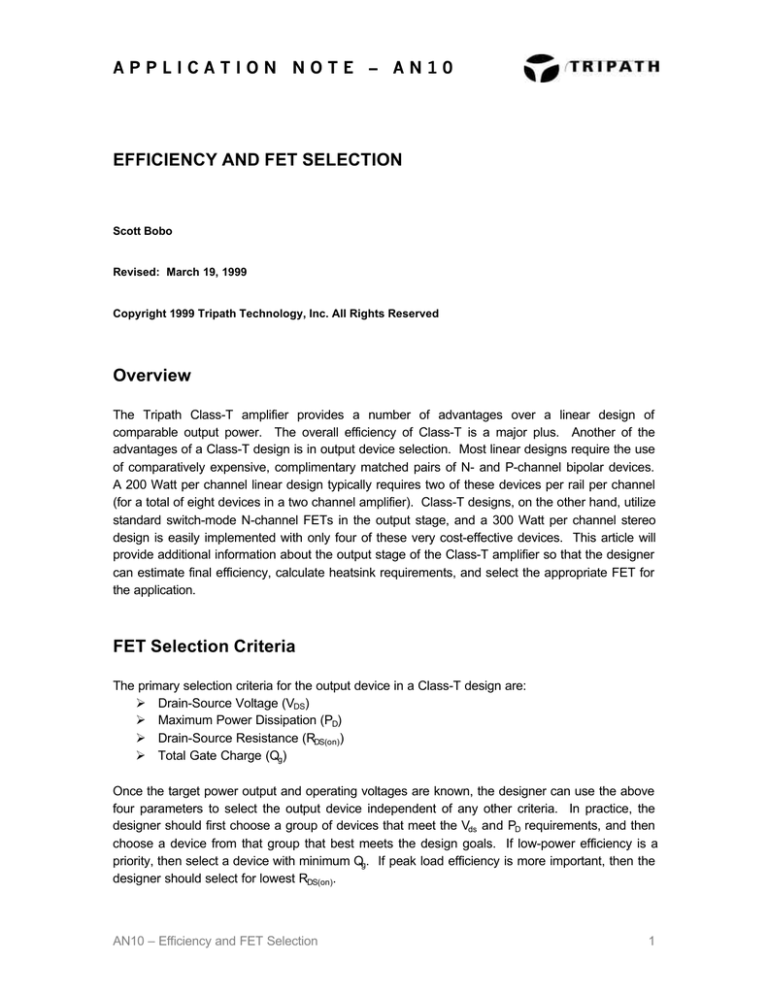
APPLICATION NOTE – AN10
EFFICIENCY AND FET SELECTION
Scott Bobo
Revised: March 19, 1999
Copyright 1999 Tripath Technology, Inc. All Rights Reserved
Overview
The Tripath Class-T amplifier provides a number of advantages over a linear design of
comparable output power. The overall efficiency of Class-T is a major plus. Another of the
advantages of a Class-T design is in output device selection. Most linear designs require the use
of comparatively expensive, complimentary matched pairs of N- and P-channel bipolar devices.
A 200 Watt per channel linear design typically requires two of these devices per rail per channel
(for a total of eight devices in a two channel amplifier). Class-T designs, on the other hand, utilize
standard switch-mode N-channel FETs in the output stage, and a 300 Watt per channel stereo
design is easily implemented with only four of these very cost-effective devices. This article will
provide additional information about the output stage of the Class-T amplifier so that the designer
can estimate final efficiency, calculate heatsink requirements, and select the appropriate FET for
the application.
FET Selection Criteria
The primary selection criteria for the output device in a Class-T design are:
Ø Drain-Source Voltage (VDS)
Ø Maximum Power Dissipation (PD)
Ø Drain-Source Resistance (RDS(on))
Ø Total Gate Charge (Qg)
Once the target power output and operating voltages are known, the designer can use the above
four parameters to select the output device independent of any other criteria. In practice, the
designer should first choose a group of devices that meet the Vds and PD requirements, and then
choose a device from that group that best meets the design goals. If low-power efficiency is a
priority, then select a device with minimum Qg. If peak load efficiency is more important, then the
designer should select for lowest RDS(on).
AN10 – Efficiency and FET Selection
1
APPLICATION NOTE – AN10
Drain Source Voltage
The choice of VDS is driven entirely by the chosen operating voltages of the amplifier design. The
device must be able to operate at the rail voltage, plus margin for ringing, thermal conditions, and
bridged operation. Tripath recommends that VDS be 50% greater than the combined rail voltage
swing. Thus for a design using +/- 33.75 Volt rails (a typical 50W design), the minimum value for
VDS should be 100 Volts. If the layout is sufficient to minimize ringing under all conditions, then
there is no need to choose a device of higher rating. Arbitrarily choosing a device of higher rating
will lead to a less than ideal value for RDS(on). (Making a device with a high voltage capability
requires that the epi layers be thicker, which means that they will be more resistive.)
Drain Source On Resistance
The efficiency of a Tripath amplifier at full load is determined largely by the resistive losses in the
output device(s). For this reason, if highest possible efficiency is the goal, the designer should
select from among appropriate devices the one with the lowest value of RDS(on).
Ø Efficiency is inversely proportional to RDS(on).
This relationship is most important in higher-power designs, as small differences in RDS(on) will
lead to large differences in heat loss.
The value of RDS(on) increases with die temperature. If the die temperature rises from 25° C (the
commonly quoted value) to 125° C, RDS(on) will typically double.
Total Gate Charge
The gate of a MOSFET is electrically isolated from the body of the device. As voltage is applied
to the gate (and the rest of the device), capacitance is created and charge accumulates under the
gate. As this charge accumulates, material under the gate (which is normally p-channel in an nchannel device) is converted to n-channel material and current then flows through the device.
This charge must be removed as the device transitions from an “on” to an “off” state, and must be
restored as the device transitions from “off” to “on”. The energy lost in turning the device on and
off is called the gate-charge switching loss and is proportional to the switching frequency,
transition time, gate voltage and current.
This lost energy translates directly to reduced
efficiency. Gate charge is essentially
2
AN10 – Efficiency and FET Selection
APPLICATION NOTE – AN10
independent of temperature and, at idle, nearly all of the power losses in the Tripath amplifier are
these switching losses.
Ø
Gate charge losses are proportional to gate charge, frequency, and voltage.
Diode Losses
The body diode of a MOSFET and the external Schottky diodes in the Tripath design are also
sources of stored charge. Diode losses occur during switching when this charge dissipates
through the RDS(on) of that channel’s active FET (on the opposite rail). Diode losses increase with
frequency and output current. Also, since the charge dissipates through RDS(on), losses increase
with temperature (though the amount of charge does not).
Ø
Diode losses are a proportional to heat, frequency, and load current.
Maximum Power Dissipation
The maximum power dissipation rating of a device (Pd) is simply a measure of the ability of the
device to withstand the heat generated by it’s own internal losses. These internal losses are
dominated by two components: I2R losses due to RDS(on), and a group of switching losses,
dominated by gate charge and diode losses. Total internal power losses must be kept below Pd
and adequate heatsinking provisions must be made to keep the die temperature below the
manufacturer’s recommended maximum value.
Ø
Maximum power dissipation in a Tripath design occurs at full load, and is the sum of
switching losses and I2R losses.
Efficiency and Loss Equations and Calculations
In the Tripath amplifier, 95% of the losses at full load are resistive and switching losses. The
proportion of the losses changes over the output range, but their sum (plus 5%) will define the
total heat load of the output stage, and thus the heatsink requirements. Note that the peak heat
load for a Tripath amplifier is reached at the maximum output level, unlike Class-AB and other
linear designs. The equations for calculating the resistive and switching losses are:
Ø Resistive losses = I2 RDS(on)
Ø Switching losses (including diode loss) = ƒ x .5Tf x V x I
AN10 – Efficiency and FET Selection
3
APPLICATION NOTE – AN10
For an IRF640 FET in a typical Tripath application (200W/channel) with Tj=140°C:
RDS(on) = .28 Ohms
Tf = 35ns (typical, with Rg=9.1Ω)
V = 40V
I = 6A (RMS)
ƒ = 200 kHz (represents full load operation)
Resistive Losses = I2 RDS(on) = 36 x .28 = 10.08W
Switching Losses = ƒ x .5Tf x V x I = 200K x .5 x 35ns x 40 x 5 = 1.18W
Total Losses = 11.26 W per device, or 45.1 W total in a 400W amplifier
Efficiency = 400 / (400 + 45.1) = 89.9%
Paralleling MOSFETS for High Power (>1KW) Designs
Many designers of higher-power amplifiers have, at one time or another, had to resort to
paralleling output devices in order to guarantee safe and reliable operation. This is a common
requirement in linear designs due to the fact that, in these designs, the output devices must
dissipate as much as 50% of the peak load. In a Tripath amplifier, however, the output devices
are only required to dissipate 10-15% of the peak load. This means that the use of paralleled
output devices is rarely necessary. Therefore, a pair of standard 125W devices (per channel) in
TO-220 (or similar) packages with proper heatsinking can safely be used in a 300W/channel
amplifier design. Using available standard n-channel devices, it is only when the power
requirements get up above 1kW that paralleled devices become necessary. For efficiency
calculations, paralleling identical devices has the effect of halving RDS(on), but doubling the
switching losses. As a consequence, idling efficiency is greatly reduced, but full power efficiency
is improved. For example, using the above values:
Resistive Losses = I2 RDS(on) = 36 x .14 = 5.04W
Switching Losses = ƒ x .5Tf x V x I = 200K x .5 x 70ns x 40 x 5 = 2.36W
Total Losses = 7.4 W per device, or 29.6 W total in a 400W amplifier
Efficiency = 400 / (400 + 29.6) = 93.1%
Should paralleled devices be needed to meet the design goals, the designer should be aware that
the Tripath TA0102A/TA0103A products are rated to drive a total gate charge of 100nC per rail
per channel. If large high-power devices are paralleled, this specification can be exceeded,
leading to unstable operation of the amplifier. Should gate charge be a limiting factor in the
design, the designer may wish to investigate the “NB” series of power MOSFETs from ST
Microelectronics. These parts have low gate charge as a function of PD .
4
AN10 – Efficiency and FET Selection





